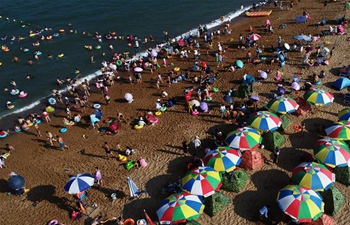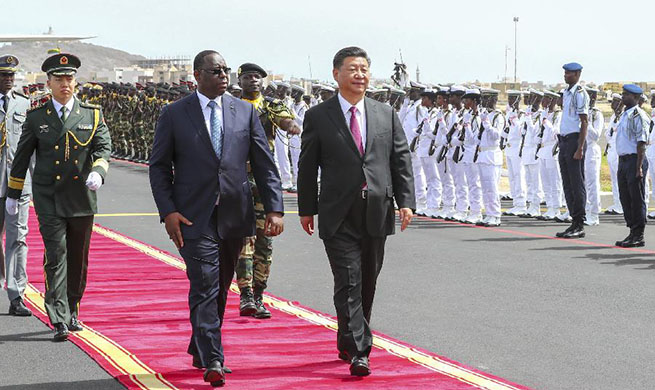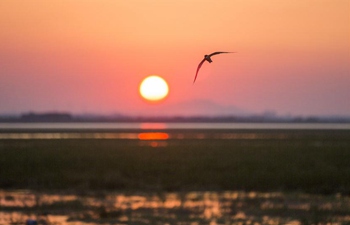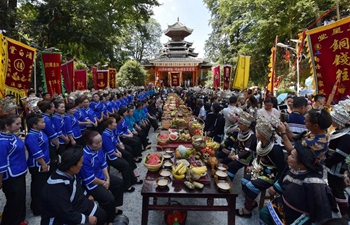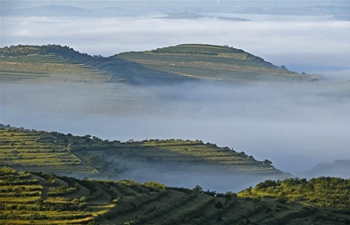by Valentini Anagnostopoulou
ELEFSINA, Greece, July 22 (Xinhua) -- As the Greek summer heats up, most people think about holidays by the sea, enjoying the sun or getting some time off. But, for the men of the 355 Tactical Transport Squadron, Greece's firefighting air force, summertime is a period of extreme alertness.
Established in 1947 and based at the military airport of Elefsina, west of Athens, the aerial firefighting squadron boasts a fleet of 11 twin-engine Canadair CL-215 and a human force of 65-80 pilots.
"These aircraft are operational all over Greece. Right now, some of them are based at the squadron, while the rest are stationed at the military airports of Samos and Andravida to cover both the east and west of the country," Lieutenant colonel Fotios Gavrilis told Xinhua in a recent interview.
CAUTIOUSNESS
So far the summer has been smooth and only minor forest fires have been reported. But the squadron is ready for the tough months of August and September ahead, where high temperatures and winds are always expected.
Simply put, their task consists of drawing water from nearby water bodies and dropping it on fires. But the task is far from simple.
As operations officer of the squadron, Gavrilis is no stranger to the challenges of the mission. Above the firefront, strong winds, dense smoke, downward air currents, heavy air traffic and turbulence increase the risks and test the crews. But water drawing is also a delicate situation, where wavelength and rapid air gusts are critical factors the operator has to take into account.
"The morphology of the terrain at the location of the fire can be the most dangerous thing. The fire is often located in a canyon, which makes it very difficult for us to go as low as we wish, because the aircraft is not very flexible when carrying water. Also the smoke can affect the aircraft's performance and camouflage high-voltage cables or high trees. Accidents are very easy to happen, if you are not extremely cautious," Lieutenant Georgios Apostolou explained.
Cautiousness is a necessary asset for the job, but it is not the only one. "First of all, one has to be calm, because when in flight, on the way to a wildfire, things are tough. Then you need standardization to perform your duties as captain or co-captain; and definitely perfect coordination and collaboration with the other aerial and ground firefighting crews operating at the same spot," Apostolou underlined.
The young pilot joined the squadron in 2012. As he says, it was his top choice. "There is this deep sense that you are providing social service. You extinguish fires, you save properties, human lives, forests. It is a very different task than what one would normally do with an aircraft," the lieutenant said.
However, It is a duty that can take a toll on the squadron's psychology. "Seeing people agonizing over their property or their life can be very stressful, it makes us more sensitive... Our conscience obliges us to be as efficient as possible," Colonel Lieutenant Gavrilis confirmed.
"There is only one aim, one focus: to collaborate and extinguish the fire," Apostolou added.
DATED AIRCRAFT
Because of its rugged terrain, Greece relies heavily on aerial firefighting for wildfire response in remote locations that ground forces often cannot approach. The water bombers can take off within 20 minutes from the emergency signal and can scoop up to 6,140 litres of water.
However, the Greek fleet is quite dated, which is one of the squadron's biggest concerns. The majority of the aircraft were purchased in 1974-1979, while the most recent acquire goes back to 1990.
"The aircraft is very old, everything on it is mechanical, and all its operations rely on the pilots, as nothing is automated," Apostolou stressed. This practically means that the operators have to constantly have their eye on all the functions while completing their mission amid rough conditions.
Nonetheless, Canadair CL-215 has stood the test of time, and with the hard work of the squadron's mechanics to keep it in fighting shape and the skillfulness of the pilots, it has proved to be a valuable weapon in Greece's battle against wildfires.
OPERATIONS TO REMEMBER
When asked about the operation that marked their career, all the senior officers of the squadron only come up with one answer: the wildfires of 2007. In the summer of that year, hundreds of forest fires broke out almost simultaneously across the country and caused the death of 63 people and 60,000 animals, burnt down 2,700 square km of land and left 6,000 people homeless. Greece declared a state of emergency, while the estimated cost of the destruction surpassed 3.5 billion euros. The fire fighting forces had to put in superhuman efforts to tackle the situation and suffered severe losses.
"The longer back you go, the more you remember, because every wildfire leaves its mark on your memory," Colonel Lieutenant Gavrilis told Xinhua.
For Apostolou, the first and biggest wildfire he had to deal with in his career was two years ago, when a blaze broke out in a rural area near the squadron's base. An hour before the young lieutenant had to join the operation, a water bomber had crashed on the mountain. Luckily the two pilots were saved, but still the morale was low. "At that time we had to empty our minds and carry on with our missions, although the situation was so tense. It is a moment I will always remember," Apostolou said.
In demanding operations like these, everything is possible, according to the officers. "It is not uncommon for [the pilots] to report to duty here at dawn, then have to fly over during the same day to Herakleion, Rhodes, Preveza, Alexandroupolis or Thassos, literally all across Greece, and in case of a raging wildfire they can end up spending weeks in a remote location, without prior notice," Gavrilis explained.
Naturally, Greek people see the men of the 355 Tactical Transport Squadron as modern-day heroes.





